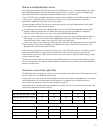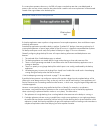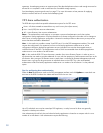
32
The number of concurrently open files in the table above do not guarantee that the D2D will perform optimally
with this number of concurrent backups, nor do they take into account the fact that host systems may report a file
as having been closed before the actual close takes place, this means that the limits provided in the table could
be exceeded without realizing it.
Should the open file limit be exceeded an entry is made in the D2D Event Log so the user knows this has
happened. Corrective action for this situation is to reduce the overall concurrent backups that are happening and
have caused too many files to be opened at once, maybe by re-scheduling some of the backup jobs to take place
at a different time.
More information on the practical implications of these limits is provided in the Backup Application
Implementation Guides; there is a separate guide for HP Data Protector 6.11, Symantec Backup Exec 2010,
CommVault Simpana 9.0 and Netbackup.
Backup application configuration
The HP D2D Backup System NAS functionality is designed to be used with backup applications that create large
“backup files” containing all of the server backup data rather than applications that simply copy the file system
contents to a share.
When using a backup application with D2D NAS shares the user will need to configure a new type of device in
their backup application. Each application varies as to what it calls a backup device that is located on a NAS
device, for example it may be called a File Library, Backup to Disk Folder, or even Virtual Tape Library. Details
about some of the more common backup applications and their use of NAS targets for backup can be found in
the Backup Application Implementation Guides.
Most backup applications allow the operator to set various parameters related to the NAS backup device that is
created, these parameters are important in ensuring good performance in different backup configurations.
Generic best practices can be applied to all applications as follows.
Backup file size
Backup applications using disk/NAS targets will create one or more large backup files per backup stream; these
contain all of the backed up data. Generally a limit will be set on the size that this file can get to before a new
one is created (usually defaulting to 4–5 GB). A backup file is analogous to a virtual cartridge for VTL devices,
but default file sizes will be much smaller than a virtual cartridge size (e.g. a virtual cartridge may be 800 GB).
In addition to the data files, there will also be a small number of metadata files such as catalogue and lock files,
these will generally be smaller than the 24 MB dedupe threshold size and will not be deduplicated. These files
are frequently updated throughout the backup process, so allowing them to be accessed randomly without
deduplication ensures that they can be accessed quickly. The first 24 MB of any backup file will not be
deduplicated, with metadata files this means that the whole file will not be deduplicated, with the backup file the
first 24 MB only will not be deduplicated. This architecture is completely invisible to the backup application
which is merely presented with its files in the same way as any ordinary NAS share would do so.
Backup size of data file
It is possible that the backup application will modify data within the deduplicated data region; this is referred to
as a write-in-place operation. This is expected to occur rarely with standard backup applications because these
generally perform stream backups and either create a new file or append to the end of an existing file rather
than accessing a file in the middle.


















